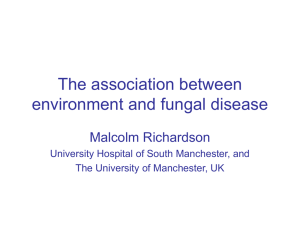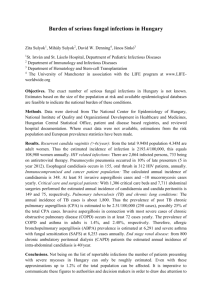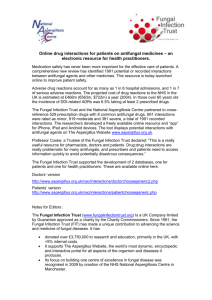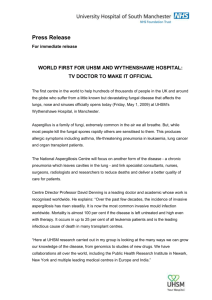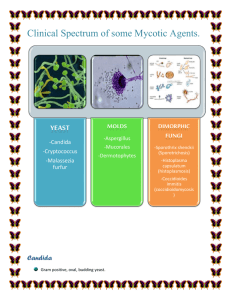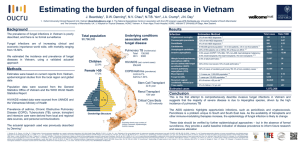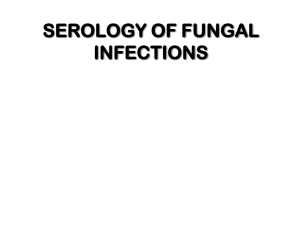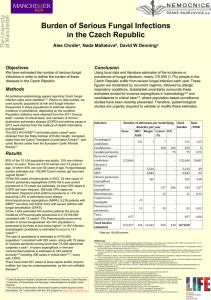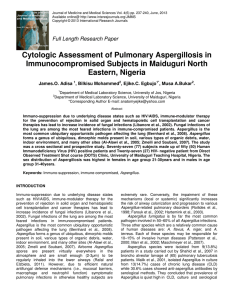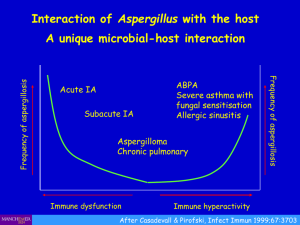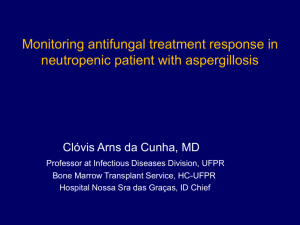Aspergillosis - Niles Animal Hospital & Bird Medical Center
advertisement
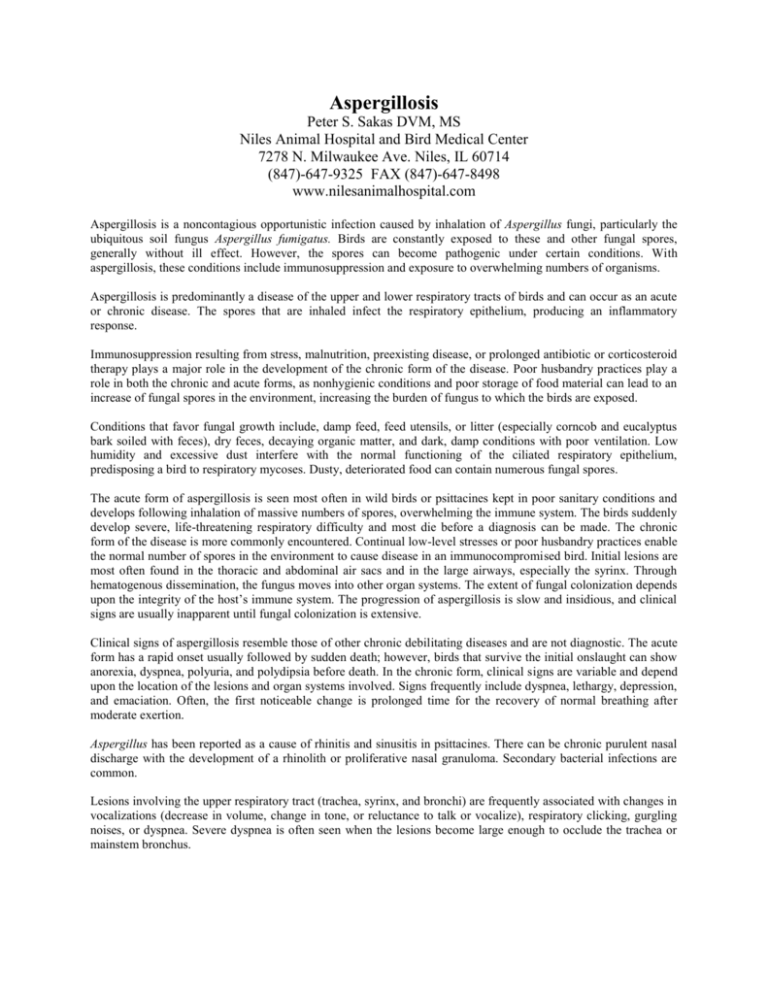
Aspergillosis Peter S. Sakas DVM, MS Niles Animal Hospital and Bird Medical Center 7278 N. Milwaukee Ave. Niles, IL 60714 (847)-647-9325 FAX (847)-647-8498 www.nilesanimalhospital.com Aspergillosis is a noncontagious opportunistic infection caused by inhalation of Aspergillus fungi, particularly the ubiquitous soil fungus Aspergillus fumigatus. Birds are constantly exposed to these and other fungal spores, generally without ill effect. However, the spores can become pathogenic under certain conditions. With aspergillosis, these conditions include immunosuppression and exposure to overwhelming numbers of organisms. Aspergillosis is predominantly a disease of the upper and lower respiratory tracts of birds and can occur as an acute or chronic disease. The spores that are inhaled infect the respiratory epithelium, producing an inflammatory response. Immunosuppression resulting from stress, malnutrition, preexisting disease, or prolonged antibiotic or corticosteroid therapy plays a major role in the development of the chronic form of the disease. Poor husbandry practices play a role in both the chronic and acute forms, as nonhygienic conditions and poor storage of food material can lead to an increase of fungal spores in the environment, increasing the burden of fungus to which the birds are exposed. Conditions that favor fungal growth include, damp feed, feed utensils, or litter (especially corncob and eucalyptus bark soiled with feces), dry feces, decaying organic matter, and dark, damp conditions with poor ventilation. Low humidity and excessive dust interfere with the normal functioning of the ciliated respiratory epithelium, predisposing a bird to respiratory mycoses. Dusty, deteriorated food can contain numerous fungal spores. The acute form of aspergillosis is seen most often in wild birds or psittacines kept in poor sanitary conditions and develops following inhalation of massive numbers of spores, overwhelming the immune system. The birds suddenly develop severe, life-threatening respiratory difficulty and most die before a diagnosis can be made. The chronic form of the disease is more commonly encountered. Continual low-level stresses or poor husbandry practices enable the normal number of spores in the environment to cause disease in an immunocompromised bird. Initial lesions are most often found in the thoracic and abdominal air sacs and in the large airways, especially the syrinx. Through hematogenous dissemination, the fungus moves into other organ systems. The extent of fungal colonization depends upon the integrity of the host’s immune system. The progression of aspergillosis is slow and insidious, and clinical signs are usually inapparent until fungal colonization is extensive. Clinical signs of aspergillosis resemble those of other chronic debilitating diseases and are not diagnostic. The acute form has a rapid onset usually followed by sudden death; however, birds that survive the initial onslaught can show anorexia, dyspnea, polyuria, and polydipsia before death. In the chronic form, clinical signs are variable and depend upon the location of the lesions and organ systems involved. Signs frequently include dyspnea, lethargy, depression, and emaciation. Often, the first noticeable change is prolonged time for the recovery of normal breathing after moderate exertion. Aspergillus has been reported as a cause of rhinitis and sinusitis in psittacines. There can be chronic purulent nasal discharge with the development of a rhinolith or proliferative nasal granuloma. Secondary bacterial infections are common. Lesions involving the upper respiratory tract (trachea, syrinx, and bronchi) are frequently associated with changes in vocalizations (decrease in volume, change in tone, or reluctance to talk or vocalize), respiratory clicking, gurgling noises, or dyspnea. Severe dyspnea is often seen when the lesions become large enough to occlude the trachea or mainstem bronchus. 2 Aspergillosis of the lungs and air sacs can cause tachypnea, dyspnea, exercise intolerance, open-mouth breathing, and audible respiratory sounds. Extensive lesions will not always cause respiratory signs, however. If a main airway is not occluded, respiratory signs may be completely absent. Aspergillosis involving the central nervous system is often associated with ataxia or paralysis. Antemortem diagnosis of aspergillosis can be difficult. In addition to the nonspecific nature of the signs of the disease, fungal mycelia are usually intimately associated with tissues, making them rarely visible in body fluids or exudates. Diagnosis is best accomplished by culture and sensitivity of the affected areas. Cytology or biopsy of affected tissue will reveal classic septate, branched fungal hyphae of Aspergillus sp. In cases where tissue samples cannot be acquired, the diagnosis can be made on the basis of clinical findings, radiography, supportive laboratory data (including hematology, serology, and protein electrophoresis), and response to therapy. A tentative diagnosis can be made when a bird presents with signs of dyspnea, voice change, exercise intolerance, chronic debilitation, and weight loss coupled with a history of exposure to immunosuppressive factors (such as stress) or environmental conditions suitable for fungal growth. Aspergillosis should be strongly suspected in cases in which a bird’s respiratory condition is not responsive to or worsens with antibiotic therapy. Hematologic findings may include severe leukocytosis (20,000 to greater than 100,000 WBC/l) with heterophilia, monocytosis, and lymphopenia. Chronic infections may also produce a non-regenerative anemia, increased serum total protein with an increased globulin portion, and if there is liver involvement, increased serum AST and bile acids. Radiographic changes may not be visible in early cases; however, with advanced disease they may include a prominent parabronchial pattern, loss of definition of the air sacs, asymmetry of the air sacs (due to consolidation or hyperinflation), or focal densities within the lung and/or air sacs. Changes may also be seen in other affected organ systems. The observation of typical lesions by endoscopy or exploratory surgery, followed by biopsy and identification of the causative agent through cytologic and histopathologic examination of the lesions, will provide a definitive diagnosis. Culture of the organism from the site of infection can also be accomplished with these methods. Serologic testing has shown great promise in the diagnosis of aspergillosis. The University of Miami (Division of Comparative Pathology/Avian and Wildlife Laboratory) provides diagnostic testing that utilizes an aspergillosis panel, including Aspergillus antigen and antibody testing and protein electrophoresis. Protein electrophoresis has demonstrated mild to moderate beta-globulin increases in approximately 30% of birds affected with mycotic disease, with more severe changes seen in birds with more acute presenting disease. Gammaglobulin increases may also occasionally be seen. Examination of avian Aspergillus titers had been inconclusive due to the low titers generally seen in many normal birds and the failure of avian species to produce significant levels of antibody. The development of an ELISA test for Aspergillus antibody, however, has been helpful in the diagnosis of aspergillosis. It tests for a group-specific antigen and thus detects reactivity to all Aspergillus species. The only known cross-reactants are molds, including Penicillum. In poor antibody producing birds and before birds develop antibody, circulating antigens can often be detected concurrent with clinical signs. Chronically infected birds demonstrate low antibody titers but positive antigen titers. With treatment, these birds become negative for antigen while producing high levels of antibodies. Through the use of paired samples, antibody and antigen titers can be measured for response to treatment. Because a significant number of confirmed aspergillosis cases have been found with weak antigen or antibody titers, results should be judged in tandem with clinical signalment. Retesting is recommended when nondiagnostic results (weak titers) are obtained to check for increasing titers and is also advised 2 weeks after completion of a treatment regimen. In chronic cases, periodic retesting is recommended even after successful treatment. 3 Gross lesions seen on postmortem examination of birds with acute aspergillosis include white, mucoid exudations in the respiratory tract, marked congestion of the lungs, thickening of the air sacs, and pneumatic nodules surrounded by areas of hyperemia. Postmortem examination of birds with chronic aspergillosis will demonstrate typical granulomatous lesions including multiple plaques or nodules of variable size that may be disseminated throughout the lungs and air sacs. These lesions are especially prevalent in the periphery of the lungs and caudal thoracic and abdominal air sacs, appear as white, yellow, or green caseous granulomatous nodules, and often exhibit sporulating fungal colonies. In severe cases, extensive adhesions between the air sacs and abdominal viscera may occur. Treatment of aspergillosis is often difficult and generally carries a poor to grave prognosis if the disease widespread. Because Aspergillus is walled off by the bird’s immune response, the granulomas are not easily penetrated by drugs, although small granulomas may resolve with long-term therapy. Prognosis improves if the granulomatous lesions are debrided, topical treatments are administered, and early, aggressive, systemic antifungal therapy is initiated. Topical treatment can include nebulization, nasal or air sac flushing, or surgical irrigation of the abdominal cavities. Antifungal agents employed in the treatment of aspergillosis include amphotericin B, flucytosine, ketoconazole, and itraconazole. Amphotericin B is generally accepted to be the drug of choice for the initial treatment of severe infections. It can be administered intravenously, intratracheally, or through nebulization and can be used in conjunction with one of the oral antifungal agents. Flucytosine is fungistatic and must be used for prolonged periods of time, up to 6 months or longer. Most fungi will rapidly develop resistance to this drug. Itraconazole has shown specificity and effectiveness against Aspergillus sp. and has been utilized to a wide extent. However, it has been shown to cause profound anorexia in African grey parrots, so it should be used with caution and administered at the low end of the dosage range. Terbinfine, a new systemic antifungal agent has shown promise. It seems to be well tolerated and is as effective as itraconazole, thus serving as an alternative therapy to birds that cannot tolerate itraconazole . Because birds affected with aspergillosis are severely compromised, they should be provided with a heated environment, fluid therapy, and supplemental (gavage) feeding in addition to antifungal therapy. Due to the risk of secondary bacterial infections, antibiotics may be needed. Aspergillosis is preventable if proper avicultural techniques are followed. All clients should be instructed to review their husbandry practices, including hygiene, food storage and preparation methods, cage location, stress factors, and other conditions that could predispose a bird to the development of the disease. Excerpted from Essentials of Avian Medicine: A Practitioner’s Guide 2nd Edition. Peter S. Sakas and Louise M. Bauck. AAHA Press. 2001
